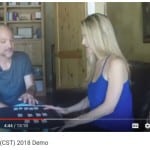Insight on Demand
 Although I do not consider insight to be the most important component in therapy, it can be very helpful when it occurs. I conduct therapy from a problem-solving perspective, which is based on the assumption that people will live happier more fulfilled lives when they are able to function as capable problem solvers. If you have attended any of my trainings, then you have probably heard me quote the axiom, “Give a man a fish, and he is fed for a day. But teach a man to fish, and he is fed for a lifetime.” Thus, as a psychotherapist, I do not consider it my job to solve people’s problems but rather to help them become better at solving any problem they encounter during the course of a lifetime.
Although I do not consider insight to be the most important component in therapy, it can be very helpful when it occurs. I conduct therapy from a problem-solving perspective, which is based on the assumption that people will live happier more fulfilled lives when they are able to function as capable problem solvers. If you have attended any of my trainings, then you have probably heard me quote the axiom, “Give a man a fish, and he is fed for a day. But teach a man to fish, and he is fed for a lifetime.” Thus, as a psychotherapist, I do not consider it my job to solve people’s problems but rather to help them become better at solving any problem they encounter during the course of a lifetime.
This brings us back to insight, which is essentially an increase in conscious understanding as well as increased motivation to make new decisions and choices. As such, insight is very valuable to any problem-solving endeavor. Furthermore, I believe in the advantages of intuitive knowledge, or what I would call “subconscious processing,” and I am happy to include it in the problem-solving endeavor whenever it occurs. Furthermore, as I talk with clients, evidence of subconscious process work often does appear.
For example, as recent as yesterday, I spotted one of my clients looking at the bookshelves in my office. On these shelves are lots of self-help book titles. I often catch clients looking in the direction of the books. Yesterday, when I asked my client what she was looking at, she replied, “There is a book title that just keeps jumping out at me—‘Hidden Guilt’.” After we briefly discussed the title, she began to experience a major breakthrough in her understanding of her marriage and her current depression. She realized that she needs to earn some income to help her husband and by the end of the session she had developed a serious business plan that could be implemented with the help of her daughter, a plan which took advantage of existing skills and a passion she has for helping the elderly transition into new living arrangements. These types of breakthroughs are common after someone achieves deep insight.
Even with these positive outcomes, I remained concerned that my bookshelves may not contain all of the titles that people need to see for their insights. So I decided to create more options by making a stack of flash cards with provocative words (e.g. sex, death, mother, over, etc.). The set that I experimented with contained 200 individual word stimulus cards. Next, I developed a sorting method designed to help integrate conscious and subconscious processing. This was highly effective but a time-consuming process. Although not nearly as long as the average hypnotic induction, it still takes a while to sort through 200 cards. Also, I still had concerns that a crucial word might be missing from my collection.
Only recently, I have come to realize that I can use “automatic writing” and simply have clients create their own much smaller set of words to sort through. Similar to a free-association task, clients are asked to write as fast as they can the first words that come to mind. This is essentially a projective technique that taps into intuitive knowledge and embodied experiences. People do not know “why” they have written certain words, but they can “feel” a strong reaction in their body when they write the word.
Similar to the work done by impact therapists, such as Danie Beaulieu, I believe the use of physical manipulatives is helpful while dealing with highly emotional, abstract realities. This helpful boost in processing ability is analogous to using an abacus to conduct mathematical processing. These cards that I use with my clients are my psychoabacus.
In order to demonstrate how this works, I asked my sister if she would sit down with me and merely write some words on paper. If you would like, you can watch this video demonstration. Keep in mind, she is not a therapy patient. She is sitting with her brother, preparing a video for the internet, and yet even without the motivation of coming to a therapist in distress over a known problem, and even without the safety of confidentiality, she still develops some powerful insights. When I do this with actual clients, in a private setting, the results are often more profound. If you would like to try this in your own practice, all that you need are several slips of paper and some practice with the steps that I list in the video. Of course, the best person to try this out on first…is you.
To see my upcoming training events, visit www.iamdrshort.com/training.htm

 BOL: I hope our conversation will focus on the how-to of intervening in order to enhance the performance of organizations. You are a master of that art, but your most important work has focussed elsewhere: on understanding the nature of the organization,...
BOL: I hope our conversation will focus on the how-to of intervening in order to enhance the performance of organizations. You are a master of that art, but your most important work has focussed elsewhere: on understanding the nature of the organization,...  BOL: Alfred Adler’s name is better known to today’s therapists than are his ideas and methods. Your dedication to this body of work must be based on the belief that contemporary practice is diminished because Adler’s contributions are not...
BOL: Alfred Adler’s name is better known to today’s therapists than are his ideas and methods. Your dedication to this body of work must be based on the belief that contemporary practice is diminished because Adler’s contributions are not...